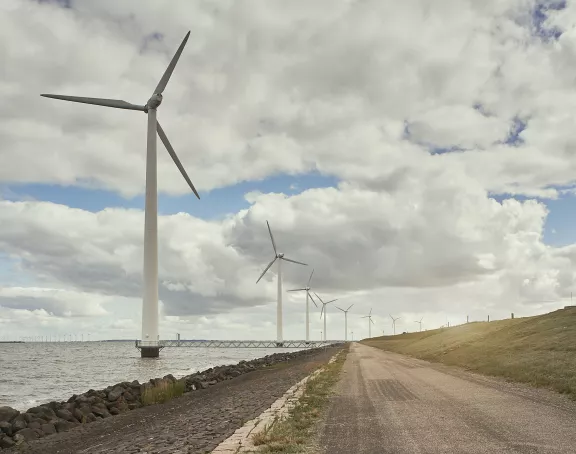National Agenda for Underground Hydrogen Storage: overcoming barriers for an essential link in energy transition
Hydrogen plays an important role in the energy transition. The hydrogen system can only function properly when the entire chain of production, transportation, storage and distribution is complete. In this regard, the Dutch government published its national agenda for underground hydrogen storage (National Agenda) on 4 July 2025. This blog outlines the National Agenda including the specific envisaged regulatory actions on permit procedures and next steps scheduled for the coming year.
National Agenda in outline: urgency and barriers to overcome
Underground hydrogen storages have long development times, which is why action is needed rather sooner than later. Large scale storage of hydrogen, a gas, is currently only possible by using suitable underground salt formations, a limited number of which currently exist in Groningen and Drenthe. Active government intervention is required to overcome existing barriers regarding the development of sufficient underground hydrogen storage: unclear regulatory frameworks affecting project feasibility, concerns on social embedding and financial risks.
The publication of the National Agenda marks an important step in the recognition of the underground hydrogen storage as a strategic asset for the Netherlands. Timely underground storage development is essential for meeting climate goals, striving for strategic autonomy and affordable domestic energy supply (chapter 1 of the National Agenda). The National Agenda indicates that storage of large hydrogen volumes is economically and practically only feasible underground, either in depleted salt caverns or gas fields onshore and offshore (chapter 2 of the National Agenda). The exact future storage capacity needs remain unclear depending on strategic decisions that are still to be made, for example regarding the amount of hydrogen designated for import and export and the type of customers (chapter 4 of the National Agenda). Given 10-15 year project cycles, immediate government action is required to meet future capacity needs (which will be ranging from 17 to 40 storage sites per 2050). However, market parties are currently held back by existing barriers such as unclear regulatory frameworks affecting project feasibility, social embedding concerns, and financial uncertainty due to market risks (chapter 5 of the National Agenda). The National Agenda Hydrogen Storage identifies 19 actions for the Dutch government to actively contribute to the development of hydrogen storage (chapter 10 of the National Agenda) in the field of (i) safety, regulatory and policy framework, (ii) social embedding, (iii) financial feasibility, (iv) knowledge development and (v) infrastructure and international (chapter 10 of the National Agenda).
National Agenda: actions aimed at overcoming the barrier of unclear regulatory frameworks
For this update, we focus on the actions aimed at overcoming the barrier of unclear regulatory frameworks affecting project feasibility, in particular relating to permit procedures (chapter 10.2.1 of the National Agenda). In general, it is important to note that the Dutch government plans to revise the legal framework for storage activities under the Dutch Mining Act. The National Agenda identifies the lack of a clear regulatory framework as a major challenge getting hydrogen storage off the ground (chapter 5, as mentioned earlier). This aligns with our practical experience in ongoing projects. The Mining Act does provide a regulatory framework for storage activities, but this framework is not tailored to hydrogen storage. The provisions date from 2003. At that time, there was little to no experience with storage and the existing experience only related to gas storage. The provisions have never been substantially updated since. In a letter to the Dutch Parliament on 31 January 2025, the government already announced the revision of the Mining Act for purposes of, amongst others, making it more future proof. In a letter to the Dutch Parliament dated 14 July 2025 regarding the progress of the Dutch government’s hydrogen policy, it is also emphasized that clear legislation and development and construction of reliable infrastructure are essential prerequisites for market development. We welcome the legislator's commitment to action as we deem it likely that this will help to mature the hydrogen storage market in the Netherlands and attract market players.
National Agenda: action points to overcome difficulties in permit procedures
The National Agenda identifies four action points for the permit procedures:
- First, the government will explore the possibilities for permit procedure acceleration with a focus on streamlining advisory processes and improving integrated information exchange between the permit authority and advisors to reduce processing times. We welcome this action point. Based on our experience, permit procedures currently often exceed statutory timelines due to their complexity and due to necessary but time consuming coordination with different advisors. We believe tighter timelines to shorten permit procedures provide greater legal certainty needed for market players to timely make investment decisions and meet construction schedules. Perhaps a covenant or strict agreements between the Ministry and advisors could help to meet statutory timelines.
- Second, the National Agenda mentions that discussions are pending with competent authorities, advisors and supervisors regarding the concept of “safety” under the Mining Act revision. Safety is a ground for refusal of an extraction or storage permit and consent for extraction and storage activities under the Mining Act. Case law shows safety cannot be interpreted so broadly as to include feelings of insecurity, except in very exceptional cases related to generally recognized risks due to gas extraction in the Northern part of the Netherlands (Groningen), see Council of State 2 December 2020, ECLI:NL:RVS:2020:2875, para. 21)
- Third, the government will explore the possibilities of integrated project assessment in permit procedures. Currently, permit procedures involving different activities (e.g., salt mining and cavern storage) are processed separately despite their interconnections. The government will explore whether early integration may improve the assessment of cumulative project impacts. This approach could be valuable but challenging, as future storage plans are often not fully clear during initial extraction permit applications.
- Fourth, it is envisaged to establish industry-regulator-government consensus on safety requirements for permanent hydrogen storage cavern closure. These requirements will be laid down in guidelines that will form a policy framework, see below.
SodM Advice
Recently, in fulfillment of one of the actions from the National Agenda, the Dutch government published its reaction to the advice it requested from the State Supervision of the Mines (Staatstoezicht op de Mijnen, SodM) regarding the concerns SodM might see regarding safety in hydrogen storage (SodM Advice). SodM published its independent advice regarding the safety of underground hydrogen storage. The advice is not a reaction to or supplement to the National Agenda, but should rather be considered a discussion document that will form the basis for discussions between SodM and the Dutch government on this matter. The advice identifies five key points of attention: (i) transparency in the balancing process between private sector interests and public interests is essential for future policymaking, (ii) the Dutch government and mining operators should clearly establish upfront how they will address safety risks and uncertainties, including how the precautionary principle (voorzorgsbeginsel) is reflected in decision-making, (iii) it is recommended to adopt a broad concept of safety, encompassing physical safety, material damage and intangible damage, to determine how responsible parties will prevent, mitigate or compensate for damage, (iv) the timely development of criteria for hydrogen storage locations, based amongst other things on safety and social integration and (v) continuous investments in knowledge development and monitoring is required. The Dutch government indicated that the advice will be addressed in the discussions on future policy frameworks.
Next steps: future legislation and policy frameworks
Several legislative and policy developments lie ahead, including the following actions policy and legislative that are planned for this year:
- Guidelines for underground hydrogen storage in salt caverns will be available by the end of 2025. The guidelines will form a policy framework emphasizing regulation and safety requirements where hydrogen storage differs from other gas storage. The guidelines will later be developed into a definitive integrated policy framework and ultimately included in the revision of the Mining Act.
- As mentioned, the Dutch government envisages to revise the Mining Act amongst others to cover for new developments such as hydrogen storage. The internet consultation of the proposal is scheduled for Q1 2026.
- In parallel, the government is preparing the Sustainable Deep Subsurface Use Programme. This will detail the locations where and conditions under which the mining activities will take place. The planning aligns with the Mining Act revision.




